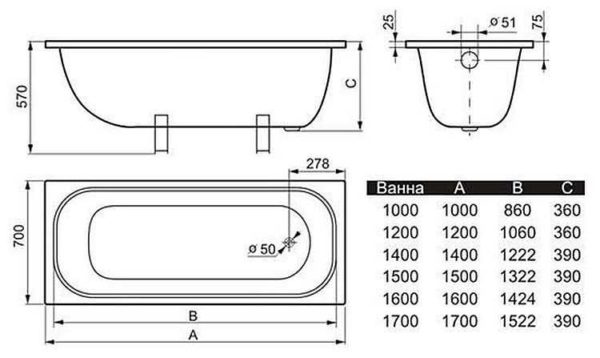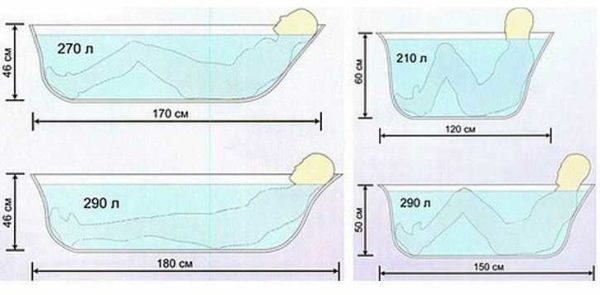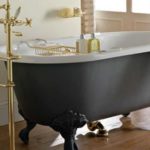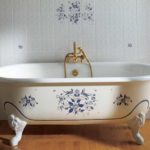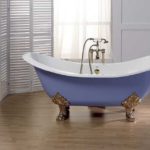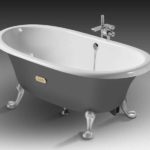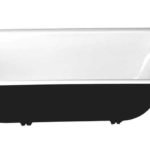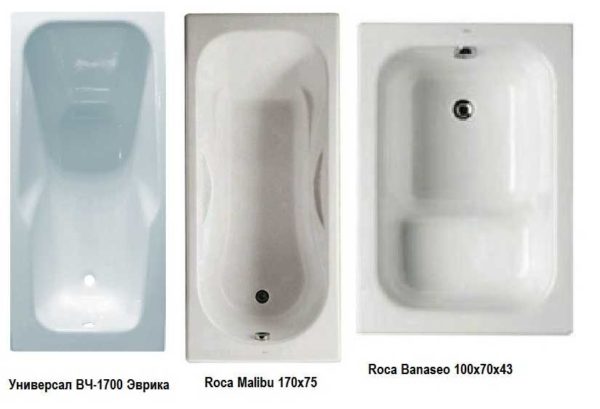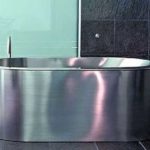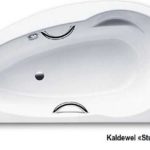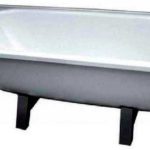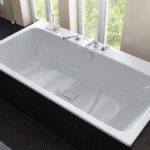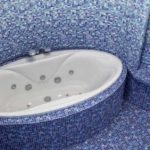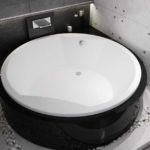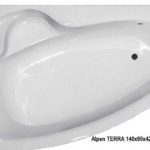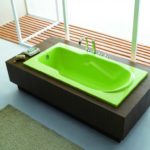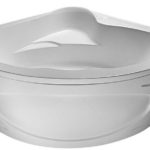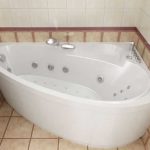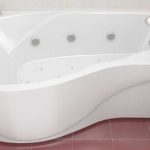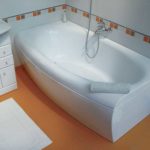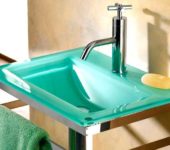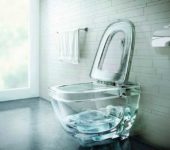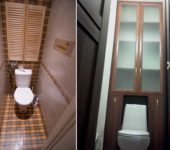Bath dimensions: steel, cast iron, acrylic
The first thing we pay attention to when entering the bathroom is a bath. It takes up a significant portion of the space. It should be beautiful, easy to care for and comfortable. Ease of use determines the size of the bath. So you need to choose it correctly.
The content of the article
Dimensions of standard baths
The choice of plumbing is one of the important points in bathroom decoration in the house and apartment. Particular attention is paid to the choice of the bath. This plumbing fixture is the largest in a small room and when planning, first of all, they decide where to put the bathtub and what size it can be. There are standard and non-standard options on sale. Standard ones are good in that you can order if necessary acrylic bath liner and thus restore its appearance and extend its service life. This type of restoration is not available for non-standard ones. They can only be updated with bulk acrylic.
What else is good about standard sized bathtubs - they are always in the assortment, you can see and touch them. The non-standard, most often, is brought under the order. You can't feel it beforehand. But standard containers are not always the best solution, since it is not always possible with them to make optimal use of the available space.
There are bathtubs of two standards on the market - Russian (post-Soviet) and European "origin". They are not very different, but these centimeters can be very useful.
| Name | Russian standard | European standard |
|---|---|---|
| Length | 150-170 cm | 150-180 cm |
| Width | 70-75 cm | 70-85 cm |
| Depth | 40-50 cm | 50-65 cm |
| Wall tilt angle | 50-80° |
How to choose the size of the bath
The size of the bath is chosen based on two parameters: the size of the room and the ease of use. With the dimensions of the room, everything is simple: if the width of the bathroom is 160 cm, you cannot install a longer bath without serious alterations in it. Then select the size that "fits" into the dimensions.
If the room is more spacious, choose for convenience. Ideally, if you can submerge in water almost completely, "reclining" with legs straight. There are other options - up to sedentary. Note that the shorter the container, the deeper it is - to keep the average person's knees and shoulders in the water.
The width of the bath is determined by the span of the shoulders - at least a couple of centimeters on both sides should remain to the sides. This is the only way to move freely. The depth depends on the first two parameters: the longer the container, the shallower it is.
Dimensions of cast iron baths
Cast iron bathtubs are loved for their reliability and durability. They serve for decades, and large people also feel confident in them - the bottom does not bend under their feet. What can be damaged is the enamel, but it can be renewed in several ways. Another plus of cast iron is that it is massive and the sound of falling water is practically inaudible. It is these properties that often turn out to be decisive when choosing.
Disadvantages of cast iron
The disadvantages are also quite serious. The first is a lot of weight. Lifting a heavy colossus up a ladder is still a task, and simply moving it horizontally is not easy. The second disadvantage is the smaller assortment in terms of non-standard shapes and sizes. This is due to the peculiarities of the technology. You will not find anything super-original. The third drawback is massiveness and high heat capacity. While the cast iron heats up, you have to stand on the cold metal. This is especially unpleasant in winter.
- Freestanding cast iron bathtubs are almost a work of art
- There is even a painting
- Enamel can be multi-colored
- Small cast iron bath
- Standard Option
Dimensions and depth
The dimensions of cast iron baths rarely differ from the standard. Even less common are containers with special shapes - armrests, recesses, etc. The shape is most often rectangular; the length, depth and / or slope of the walls can differ. Other options are very expensive and rare. You can often find three options:
- Big ones. 170-180 cm long, 70-85 cm wide. In them you can lie down and relax at ease. For ease of use, handrails are often added.
- Average. Their length is 140-160 cm, width is 70-75 cm. This option is also called semi-seated. You can lie in them with your knees bent. It is this option that is often installed in standard apartments, since larger ones simply do not become without moving the walls.
- Small. The length of these cast-iron baths is 120-130 cm, the width is the same - 70-75 cm. An adult can only sit here. This is an option for small bathrooms in Khrushchev, into which you also need to squeeze the washing machine.
The depth of cast iron baths is usually standard and is 65 cm, which is slightly more than others, so the volume of these containers is also larger.
Imported cast iron bathtubs can be enameled inside and out. They are used for surface installation without screen, they often also have decorative legs. So they look presentable. But this option is more suitable for spacious rooms. Laconic, no-nonsense models fit better into small ones.
Steel
Steel baths are not as durable as cast iron, but they cost much less (three to four times normal and twice - made of stainless steel). Their other advantages are less weight, lower heat capacity (they heat up faster), more options for shapes and sizes. They are made from black and stainless steel. Steel is always torn by enamel, which protects them from destruction, stainless - not always.
The disadvantages are significant. If the enamel is damaged, ordinary steel quickly collapses, therefore the condition of the coating must be carefully monitored. At the same time, its walls are thin - up to 3 mm thick, and under heavy load they can bend, causing cracks in the enamel. If you want a steel bath to serve for a long time, it must be installed on a reliable frame supporting the bottom and walls (usually made of bricks or building blocks). The second minus is that they are very "loud". If the bath is not overlaid with soundproof materials during installation, the water jet "sounds" no worse than a drum.
- Stainless steel bathtub without enamel
- There are also unusual shapes
- This is a classic
- The drain can be centered
- Standard Option
The size of a steel bath is often in two gradations: large (150-180 cm long) and medium (130-140 cm long). In shape, they are often rectangular, but there can be several unusual shapes - in the form of an oval, a trapezoid, a rectangle (almost without rounded corners), with a seat. Metal sitz baths (small sizes) are rare, but can be found if desired.
Acrylic - sizes and shapes
Acrylic is a durable chemically neutral polymer with a wide range of applications. Baths are also made of it. Moreover, acrylic bathtubs are available in a variety of shapes and sizes. It is they who are round, oval, angular, complex shapes (in the form of beans, for example). The walls may not be straight, but rounded, with smooth curves. The bottom can be with steps, there are often seats, recesses, armrests and other "excesses" that make operation more convenient. Various sprays and hydromassage nozzles are built into the acrylic bathroom.
Advantages and disadvantages
Acrylic is a much less heat-absorbing material than steel and cast iron. This means that it heats up faster.And this is another plus. The next positive quality is that it is lightweight. An acrylic bathtub of any size can be easily carried by one person. Another positive point: the size of the acrylic bath can be ordered. The material is plastic, it can be given any shape, and the technology is such that you can make a container, both large and small.
- Oval bathtub for custom interiors
- The round one can only be placed in a spacious room
- Asymmetric shapes are also common
- Acrylic can be colored
- The size of the bath installed in the corner is based on the length of the side
- With built-in hydromassage
- Smooth, curved shapes reduce the likelihood of injury
- The frame is covered by a screen
Now about the disadvantages. The walls of the acrylic bathtub are thin, and bend under load. Not a pleasant feeling. Because any acrylic bath set on a frame made of metal or bricks (building blocks), the frame itself is then covered with a screen.
Attention to the quality of acrylic
Durability and ease of maintenance depends on the quality of the polymer used. The best is sanitary acrylic, poured onto a fiberglass base with a layer of at least 2-3 mm. But such copies cost a lot. Often more expensive than steel, and the prices for some acrylic baths are no less than cast iron ones. But they serve for a long time and wash normally. By the way, the care of the acrylic bathroom is special. It can only be washed with certain sponges and special non-abrasive products.
The dimensions of acrylic bathtubs should be described by shape, since they are different.
- Standard form. Length from 140 to 185 cm, width 75-90 cm, depth 40 - 65 cm.
- Round. Diameter from 140 to 200 cm, but may be larger.
- Corner. Here the dimensions are determined by the length of the side - from 140 cm to 180 cm, depth - 45-65 cm.
It is difficult to determine the size of unusual shapes. They are usually supplied to order or custom made. So if you need a bathtub size exactly for your room or an unusual shape, your choice is unambiguous - acrylic.

